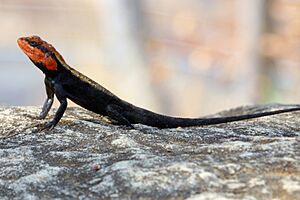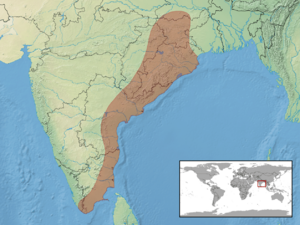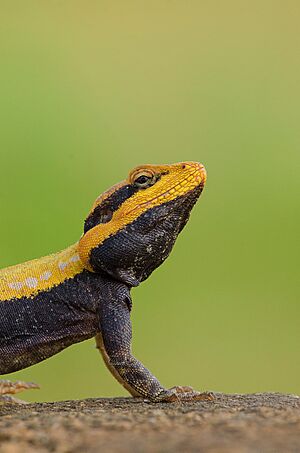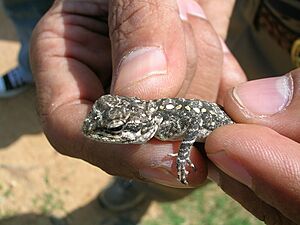Peninsular rock agama facts for kids
Quick facts for kids Peninsular rock agama |
|
|---|---|
 |
|
| Male | |
 |
|
| Female | |
| Conservation status | |
| Scientific classification | |
| Genus: |
Psammophilus
|
| Species: |
dorsalis
|
 |
|
| Synonyms | |
|
|
The Peninsular Rock Agama (also called the South Indian Rock Agama) is a type of lizard. Its scientific name is Psammophilus dorsalis. You can often find these lizards on rocky hills in southern India. There's a similar lizard, the Psammophilus blanfordanus, but it lives a bit further north in the Eastern Ghats mountains.
Contents
About the Peninsular Rock Agama
This lizard has a large head that looks long and a bit flat. In adult males, their cheeks can look swollen. The front part of their nose (snout) is longer than their eye. The scales on top of their head are not all the same size. They can be smooth or slightly bumpy.
You might see two small spines or groups of spines above their ears, but sometimes these are missing. The lizard's eardrum (called the tympanum) is about half the size of its eye. They have many scales around their mouth, both on the upper and lower lips.
Body and Scales
The agama's body is a little flat. The scales on its back are small and usually smooth in adults. Young agamas have bumpier scales. All the scales point backward and upward. There's a small ridge of slightly bigger scales along its back, but it's not a big crest. The scales on its belly are about the same size as those on its back and are smooth.
Under its chin, the scales are a bit smaller. There's also a strong fold of skin across its throat, covered with tiny scales. The crests on its neck and back are like small, tooth-shaped bumps.
Legs and Tail
Their legs are strong and covered with bumpy scales. When a hind leg is stretched forward, it can reach the lizard's ear or even the back of its eye. Younger lizards can stretch their legs even further.
The tail is a bit flat and covered with bumpy scales. The scales on the underside of the tail are larger than those on top. In adult males, the base of the tail is noticeably swollen. The scales in this swollen area are thicker, and the scales in the middle row on top are larger.
Colors and Appearance
Young agamas and females are usually olive-brown. They have dark brown spots, speckles, or patterns. They also have a line of white, long spots along each side of their back.
Male agamas have pale brownish colors on their head and back. Their lips are yellowish-brown, and this color continues as a stripe behind their ear. A dark brown or black stripe starts behind the eye and gets wider, covering the lower sides of their body. Their underside is yellow, and their throat often has grey patterns.
These lizards like to warm themselves in the sun on bare rocks. Their colors help them blend in, making them hard to spot. They eat insects. During the breeding season, male agamas become very colorful. Their upper body can turn bright red or yellow, and their lip stripe might even be pink. Their underside, legs, and tail become black.
From their snout to their vent (a small opening on their underside), these lizards can be about 135 millimeters (about 5.3 inches) long. Their tail can be about 200 millimeters (about 7.9 inches) long. Females are usually smaller than males.
Lizard Behavior
Male Peninsular Rock Agamas often bask (lie in the sun) openly on rocks. They perform "head push-up" displays, which might be a way to show off to other lizards. Larger males usually choose higher spots to perch. When birds fly overhead, these lizards flatten their bodies to hide better. Scientists have found about 90 of these lizards in an area the size of a hectare (about 2.5 acres).
Where They Live
You can find Peninsular Rock Agamas in southern India, generally south of 16°N latitude. They live in hilly areas, including the Western Ghats, Nilgiris, South Arcot, and Nallamalai Hills. They can be found at high altitudes, up to 6,000 feet (about 1,800 meters) above sea level in the Nilgiris. They are very common in some parts of the Nilgiris. M.A. Smith noted in his book The Fauna of British India that they were especially common near Bangalore.




